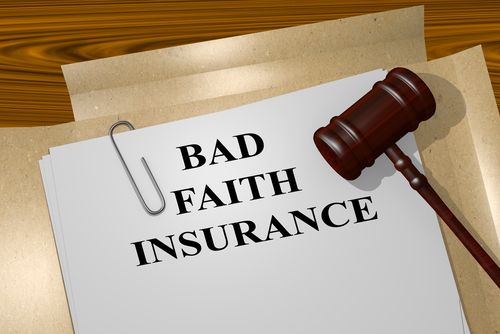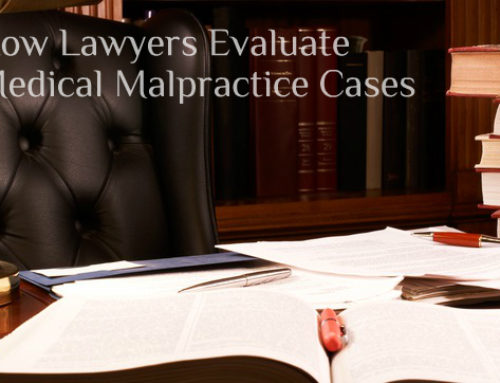The sense of security you have from knowing you’re insured might be a false one. Unfortunately, you won’t find out you have bad faith insurance until your carrier fails to uphold its duties. Sometimes it’s another person’s or company’s insurance that doesn’t come through. Even when an insurance company denies or diminishes your payment, you still have legal rights.
How to Spot Bad Faith Insurance
People buy different types of insurance policies for different areas of their lives. Most people have car insurance to pay for property damage or bodily injury in case of a wreck. In no-fault states, you would file a claim with your own insurance company for your losses regardless of who caused the wreck. In fault insurance states, you usually file a claim with the at-fault driver for compensation. If someone else causes your injury, they are responsible for your medical bills and other damages.
Some businesses purchase liability insurance to protect them in case their employees or customers get hurt. Workers’ compensation is a type of insurance employers buy that protects employees and their employers both. It provides compensation when the employee gets injured on the job and protects the employer from a lawsuit.
The majority of people in this country now have some type of health insurance. You might have insurance through your employment, the government, or from a private insurance company. You rely on your health coverage to pay for emergency, preventive, and ongoing medical care.
You probably have insurance on your home, too. Some policies protect homeowners from fire, theft, vandalism, flooding, and damage from severe weather. Most mortgage companies require insurance for new constructions in case damage occurs before the structure is complete.
These are just some of the common types of insurance that many people carry. When you sign up for an insurance policy, the insurance company agrees to provide you with certain coverage under specific types of circumstances in return for the premiums you pay. If they fail to meet these duties in any of several ways, then they fail to act in “good faith.”
Some of the ways to spot bad faith insurance are when the company…
– Misinterprets the language in their policy
– Spends a lot of time delaying payment of your claim
– Makes unjustified demands for proof of your injuries or damages
– Uses abusive tactics to frighten you
– Requests a contribution from you upfront before agreeing to pay the rest
– Fails to investigate the cause of your injuries and your losses
If you must repeatedly call the insurance company only to be put off, you might have a claim. You have the legal right to have your damages investigated and paid promptly. When the insurance company fails to deal with your claim in good faith, you might have grounds for a bad faith insurance claim.
Automobile Insurance Policy Limits
Each state imposes minimum limits for the types and amounts of insurance you must carry. In Maryland, the minimums are $30,000 per injured person and $60,000 per accident total. The greater the damage to the vehicle and the more severe or numerous the injuries are, the less likely it is that the insurance will cover all the damages.
One of the tactics listed above deals with telling you that the policy limits are lower than they really are. That means that if the insured has double the minimum coverage, the insurance company claims they only have the minimum amount. That way, they can pay the “maximum policy limit” and still pay only half of what you are entitled to.
Car wrecks happen all the time. Many of them don’t have adequate coverage for all the damages. Victims often have damages well above the total amount of coverage available. Maryland recognizes bad faith insurance claims and strives to evaluate claims and settle cases within the available policy limits. This prevents the process from jeopardizing the insured’s assets. If your injuries exceed the at-fault driver’s policy limits, you might get a judgment that exceeds the policy limits. The cause of action for the bad faith failure to settle the claim is with the insured, not the injured party.
To obtain a bad faith judgment, the injured party must obtain an assignment of the insured person’s bad faith claim in exchange for an agreement not to pursue the insured’s assets. Maryland has an assignment procedure that is approved by the Maryland Court.
Maryland determines damages by the amount which the judgment rendered exceeds the amount of insurance company. Maryland doesn’t allow punitive damages unless the injured party can prove that the insurance company acted with specific malice.
The courts will consider multiple factors when evaluating whether the insurance company’s refusal to settle within policy limits was due to…
– the severity of injuries greatly exceed the policy limits
– there was a lack of proper investigation
– lack of skillful evaluation of plaintiff disability
– failure of the insurance company to provide the insured with a compromise offer within or near policy limits
– pressure on the insured to contribute to settlement within policy limits as an incentive to settle
– actions that demonstrate the insurance company’s greater concern for the company’s monetary interest than for the financial risk to their client
First-Party Claims
These claims are the ones you file with your own insurance company. For example, if your home burns or floods, you file a claim with your homeowners’ insurance policy. The agent shouldn’t recommend delaying the repairs until they properly investigate your home. In fact, they shouldn’t prevent you from starting repairs right away. Failing to take your calls and not returning those you make is a red flag they are acting in bad faith.
Some claims are straightforward and don’t require a lot of investigation. If your policy says that it covers home fires from any cause, the insurance company shouldn’t put off paying your claim. If the agent is vague about when they will visit the location of the property, and they never show up, it’s probably time to see an attorney. There are state insurance laws that insurance companies must adhere to. A local attorney can advise you on your rights and what steps to take in a bad faith case.
Third-Party Claims
These types of claims involve liability insurance. The insurance company has a duty to defend and pay all the defense costs even when most or some of the lawsuit isn’t covered. The exception to the rule is with a “burning limits” policy. With these policies, the defense costs consume the policy limits. The insurance company might also have a duty to pay a judgment up to the policy limits on losses that are covered.
Some jurisdictions also impose a duty on the insurance company to settle a reasonably clear claim when the insured is liable within policy limits. This helps them avoid the risk of a judgment exceeding policy limits. For example, imagine striking a pedestrian while texting and driving. The impact causes severe injuries to the pedestrian, and they sue you. They demand the full policy limit of $125,000, although their actual damages were more than double that amount. You tender the pedestrian’s demand for economic damages and your defense to the insurance company, along with an explanation that you were texting and driving. If the insurance company refuses to make a reasonable settlement within policy limits and you go bankrupt paying the judgment, you have a right to file a bad faith lawsuit against the insurance company.
What Is a Bad Faith Lawsuit?
Any time your insurance company breaches their duty of good faith and fair dealing, you have the option to file a common-law tort claim. The types of claims vary from state to state. An attorney will advise you to your rights according to your state of residence.
A bad faith insurance company might be liable for damages beyond the policy limits. In addition, the court might order them to pay statutory penalties, consequential economic losses, emotional distress, attorneys’ fees, and punitive damages. In cases where the law allows punitive damages, the amount is determined by the insurer’s wealth and not entirely on the insured’s actual losses.
Why Bad Faith Insurance Claims Happen
The insurance company has a lot of control over your insurance claim. It’s what they do every day! Their goal is to pay out as little as possible in claims. They know which tactics work and they rely on your naivete about the system and the law to help them get away with it.
Insurance companies deal from a position of strength. They know how to negotiate to get you to accept a lesser amount. They also have greater financial resources to draw on. But the courts know how the insurance companies work, too. That’s why most find an obligation of good faith and fair dealing on the part of the insurance company.
If your insurance company doesn’t act reasonably and in a timely manner in processes, investigating, or paying your claim, contact a personal injury attorney to discuss your case. Depending on the laws in your state, you might have the right to file a lawsuit. Every case differs in what constitutes a bad faith claim.
States also differ in how they define bad faith. Some consider behavior that is unreasonable or without proper cause. Others have a narrower view. They might only find liability when a denied claim is not fairly debatable, and the insurance company realizes this is the situation. In some states, bad faith is a breach of contract while others classify it as a tort. In the latter, you must usually prove that the benefits under the policy were withheld and the reason for withholding benefits was unreasonable. It’s up to you to prove that you had a valid claim under the terms of your policy and that the insurance company failed to have a valid reason to deny your claim.
Courts consider some actions as bad conduct that help in deciding if an insurance company acted unreasonably. Any of the following details might help you prove a bad faith insurance claim denial.
- Misrepresentation of relevant facts about the case or provisions in the insurance policy.
- They failed to adopt and implement reasonable standards for investigating and processing the claims.
- They failed to acknowledge receiving a claim and didn’t respond promptly after receiving it.
- They failed to approve or deny the claim within a reasonable time once you submitted proof of your losses.
- The insurance company didn’t provide a reasonable explanation as to why they denied your claim.
Why Hire a Personal Injury Attorney for Bad Faith Insurance Claims
Personal injury lawyers have a lot of experience handling bad faith insurance claims. They can explore all your options for getting additional coverage or establishing bad faith so that compensation in excess of policy limits can be obtained. Although it isn’t possible to get compensation that exceeds policy limits in every case, your case might be an exception. If you are seriously injured, hiring the right lawyer is the most important step you can take. A personal injury attorney understands the law and your rights. Dealing with bad faith insurance claims requires the highest level of expertise.
You need medical treatment for your injuries. You deserve compensation for your claim without the stress of dealing with bad faith tactics by the insurance company. An experienced personal injury attorney knows the tactics insurance companies use. He knows how to negotiate with bad faith insurance companies and get you the maximum amount of compensation allowed.
Why Choose Ingerman & Horwitz?
Ingerman & Horwitz has a reputation throughout Maryland for our commitment to justice and dedication to excellence. Our attorneys have achieved undeniably great results for our clients. If you aren’t sure if you have a case, let us help you find out. Contact us to schedule a free consultation to discuss the details of your case. It costs you nothing to speak with an experienced personal injury attorney.















